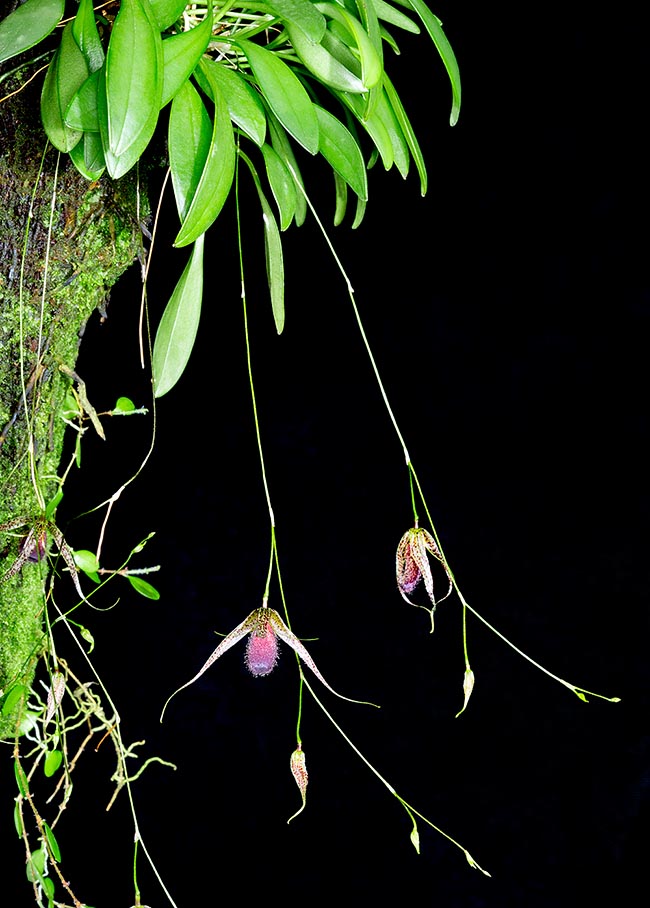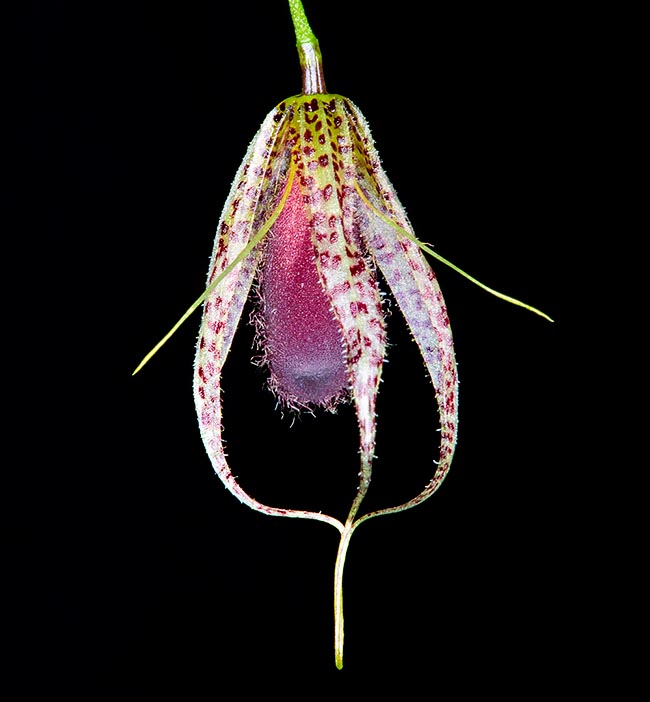Family : Orchidaceae

Text © Pietro Puccio

English translation by Mario Beltramini

The Muscarella megalops is an epiphyte native to the humid Ecuador forests, between 1500 and 2500 m of altitude © Giuseppe Mazza
The species is native to Ecuador (Azuay) where it grows on the trees of the humid forest between 1500 and 2500 m of altitude.
The name of the genus comes from Muscaria, similar genus, in turn coming from the Latin substantive “musca, ae” = fly, alluding to the shape of the flower; the specific name is the combination of the Greek adjective “μεγάλα” (megala) = big and of the substantive “ὄψις” (opsis) = face, look, with reference to the labellum.
The Muscarella megalops (Luer) Luer (2006) is a cespitose epiphyte species with creeping rhizome and thin unifoliate stems, 0,5-1 cm long, enclosed by two tubular sheaths.
Obovate erect leaves with acute to obtuse apex and long narrow base, coriaceous, 3-4,5 cm long and about 0,8 cm broad.
Inflorescences, on a 4-5 cm long filiform supple peduncle, racemose, arcuate basically falling back, broad, up to about 15 cm long, with numerous flowers opening in succession of 2-3 cm of diameter.
Pedicel and ovary of about 1 cm of length, free sepals, similar, oblong with caudate apex, keeled, about 2,2 cm long and 0,3 cm broad, translucent, of greenish white colour with purple speckles, ciliate.
Strictly triangular petals with long acuminate apex, about 1,4 cm long and 1 mm broad at the base, translucent, of greenish colour, with long and scattered hairs at the base.
Obovate labellum with two erect lobes at the base, convex, pubescent and densely ciliate outside, of purple red colour, about 1,3 cm long and 0,6 cm broad, and column, about 3 mm long, of green colour.
It reproduces by seed, in vitro, but usually by division, with each section provided of at least 4-5 stems.

An opening flower reaches the 2-3 cm of diameter. Easy to cultivate forms dense tufts © Giuseppe Mazza
Miniature orchid with characteristic flowers among the largest of the genus, distinguishing in particular for the appearance and the size of the labellum, that form in short time dense tufts.
Of rather easy cultivation, requires a semi-shady position, cool temperatures, with lowest night ones not under the 8 °C, high humidity, 70-80 %, and constant ventilation.
It may be mounted on pieces of bark, rafts of cork or of arborescent ferns, or cultivated in pot with a draining compost that can be formed by slices of bark of medium size, charcoal and sphagnum.
Regularly distributed watering, as not having a precise rest time, even daily for the mounted plants, but avoiding stagnations that may cause rottenness, utilizing rainwater, by reverse osmosis or de-mineralized.
Monthly fertilizations with a product specific for orchids at ¼ of the dosage shown in the package.
The species is inscribed in the appendix II of CITES (species whose trade is internationally ruled).
Synonyms:
Pleurothallis megalops Luer (1982); Specklinia megalops (Luer) Pridgeon & M.W.Chase (2001).
